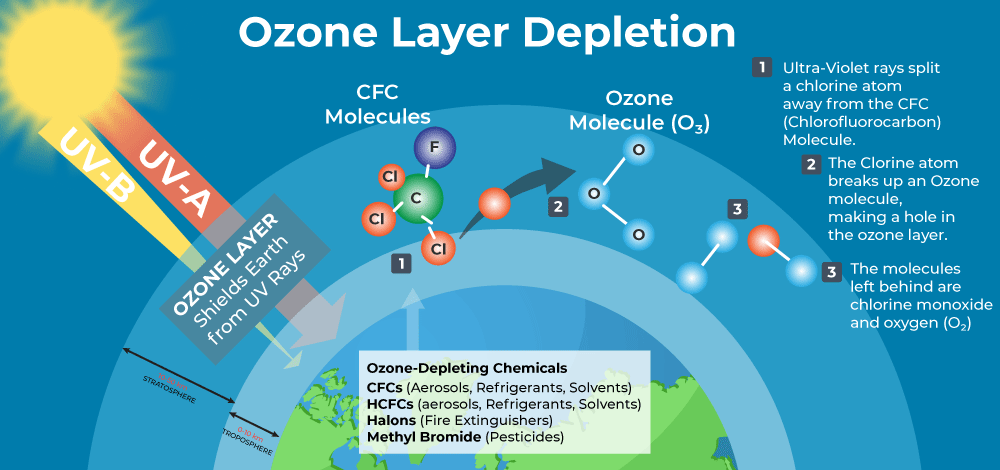-
14 Mar 2025
GS Paper 3
Bio-diversity & Environment
Day 89: What are the major causes of ozone layer depletion? Evaluate the impact of global initiatives like the Montreal Protocol in curbing ozone-depleting substances. How has India aligned its policies with these efforts? (250 words)
Approach
- Briefly introduce the significance of the Ozone layer.
- Discuss the major causes of ozone layer depletion.
- Evaluate the impact of global initiatives.
- Discuss India’s alignment with Global efforts.
- Conclude Suitably.
Introduction
The ozone layer, located in the stratosphere (10-50 km above Earth), absorbs harmful UV radiation and protects life on Earth. It consists of ozone (O₃) molecules, formed when oxygen (O₂) interacts with solar radiation. Ozone layer depletion refers to the thinning of the ozone concentration due to human-made and natural factors.
Body
Major Causes of Ozone Layer Depletion
- Chlorofluorocarbons (CFCs) – Primary Cause
- CFCs are used in refrigerators, air conditioners, aerosol sprays, and foam-blowing agents.
- Once released, they break down ozone molecules, creating the ozone hole over Antarctica (first detected in 1985).
- Halons and Bromine Compounds
- Found in fire extinguishers and industrial solvents, halons are 10 times more destructive to ozone than CFCs.
- Bromine is 60 times more effective at ozone destruction than chlorine.
- Hydrochlorofluorocarbons (HCFCs) & Methyl Bromide
- HCFCs were introduced as a transitional substitute for CFCs but still harm ozone.
- Methyl bromide, used as a pesticide, has a high ozone depletion potential (ODP).
- Nitrous Oxide (N₂O) – The Emerging Threat
- Released from fertilizers, fossil fuels, and biomass burning, nitrous oxide has surpassed CFCs as the largest ozone-depleting gas.
- A 2018 NASA study highlighted N₂O as the biggest long-term ozone threat.
- Released from fertilizers, fossil fuels, and biomass burning, nitrous oxide has surpassed CFCs as the largest ozone-depleting gas.
Impact of Global Initiatives like the Montreal Protocol
- The Montreal Protocol (1987) – A Landmark Agreement
- First global treaty to be universally ratified (by 198 countries).
- Objective: Eliminate ODS like CFCs, HCFCs, and halons.
- Success Stories:
- 98% of ODS phased out globally (UNEP, 2022).
- The ozone hole in Antarctica is shrinking (expected recovery by 2066, per WMO).
- The Kigali Amendment (2016) – Next Step in Ozone and Climate Action
- Targets Hydrofluorocarbons (HFCs), which do not deplete ozone but contribute to global warming.
- Expected to reduce global warming by 0.5°C by 2100.
- Countries committed to phasing down 85% of HFCs by 2047.
- Ongoing Challenges
- Illegal production of banned substances: CFC-11 emissions detected in some countries despite the ban.
- Developing countries face financial & technological barriers in transitioning to alternatives.
India’s Alignment with Global Efforts
- Early Adoption of the Montreal Protocol (1992)
- India phased out CFCs by 2010 and is phasing out HCFCs by 2030, as per the Ozone-Depleting Substances (Regulation and Control) Rules, 2000, in line with the Montreal Protocol's accelerated schedule
- India's HCFC Phase-out Management Plan (HPMP) led to a 35% reduction in HCFC use by 2020.
- National Cooling Action Plan (NCAP) (2019)
- Aims to reduce cooling demand by 25-30% and refrigerant use by 85% by 2037-38.
- Promotes energy-efficient cooling technologies and natural refrigerants like ammonia.
- Kigali Amendment Ratification (2021)
- India pledged to reduce HFC consumption by 80% by 2047.
Conclusion
The Montreal Protocol has been a global success, reversing ozone depletion trends. India’s proactive measures, including policy alignment with global agreements, phase-outs of harmful substances, and promotion of sustainable cooling, demonstrate its commitment. However, continuous innovation and strict enforcement are needed to ensure full ozone recovery and climate-friendly alternatives.





